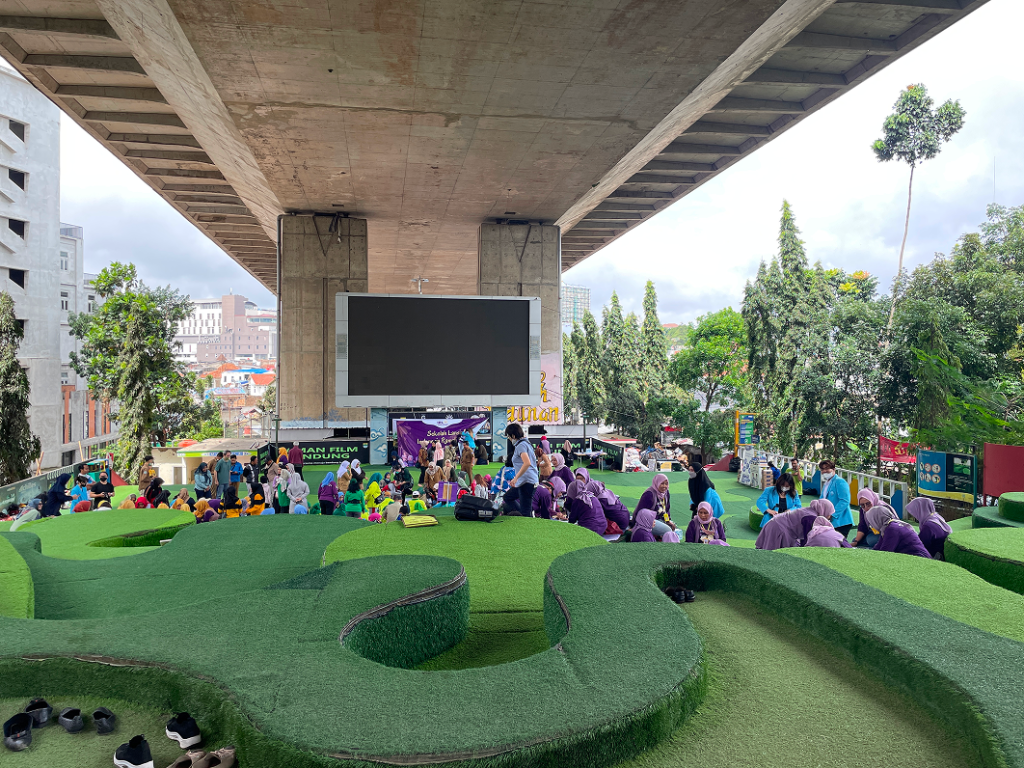Bandung, Indonesia
Under Pasopati Flyover
The Beginning
The story begins with the construction of the Pasupati Flyover in the early 2000s. Stretching about 2.8 km long and 21.53 meters wide, the flyover connected northern and eastern Bandung across the Cikapundung valley. While it became an icon of the city, its underpass left a large empty space that was poorly managed. Over time, this vacant land was used by marginalized groups as temporary shelters and sometimes for unhealthy activities such as drinking or drugs.
In 2014, under The Newly appointed Bandung government, a vision to improve Bandung’s happiness index led to the reactivation of neglected public spaces through a program called Thematic Parks. One of these was Taman Film, located right under the Pasupati Flyover. Officially opened on September 14, 2014, Taman Film transformed the empty underpass into a vibrant public park. It was equipped with a large outdoor videotron screen, terraced seating, free movie screenings, Wi-Fi access, and space for up to 500 people in a 1,300-square-meter area. The park quickly became a new attraction in Bandung, offering residents—especially youth—a cleaner, safer, and more enjoyable public space.
The Unfortunate Reality
We saw enormous potential in the Taman Film and Lapangan Bawet area. Its location is close to schools and universities, surrounded by many young people, and Kelurahan Tamansari itself has an active youth community. This makes it a promising hub for innovation. Yet when we first began this initiative in November 2022, our field survey revealed a very different reality—the park was poorly maintained, and even the futsal field was no longer usable. Trash piled up, visitors showed little care for cleanliness, and the open field was taken over by illegal parking.
Through a series of activities, we hoped to spark change in how public space is understood and valued. Our vision was for the community to feel a sense of ownership, because once that happens, care and stewardship naturally follow. The recovery process was not linear, but it gave us valuable insights into how neglected urban corners can be brought back to life.
Our Action
The first step was identifying needs. We gathered data through direct observation, surveys, interviews, and focus group discussions with both visitors and local residents. At Taman Film, we noticed children spent long hours playing, running, and chatting, while adults used the space for group exercise or community practice. Clearly, there was a need for wide, open play areas. Ironically, a multipurpose field right next to the park could have served this purpose—yet it was dominated by travel buses and vans parked illegally, leaving the community without access.
Other issues emerged. The park was lively during the day but became empty at night, its potential wasted due to poor facilities. Visitors were also required to remove their shoes before stepping onto the synthetic grass, but the absence of proper storage meant shoes were scattered messily at the entrance. These small but persistent problems highlighted how design and management directly affect how people use public space.
To address these challenges, we engaged stakeholders with multiple approaches: interviews to understand needs, focus group discussions with residents and government departments, and collaborative design tools that gave the community a voice. We also partnered with Karang Taruna, the local youth group, ensuring our programs aligned with local aspirations and gained trust. This work demanded patience and communication, but every effort proved worthwhile.
Interestingly, surveys revealed that many young people and students were not even aware that these public spaces existed. This finding underscored the importance of not only improving infrastructure but also raising awareness, so these parks can become truly inclusive, accessible, and alive with community activity.
Read the complete story here


